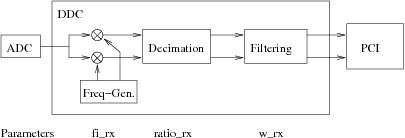Subsystems
The software-radio has a reception and a transmission part. Each one of these has its specialities and quirks. Here I list the names used in programming, the restrictions and how they come across. Only the reception-part is treated in this document, as the transmission-part is quite simple.
Nyquist
It is very important to understand the implication of Nyquists theorem for this reception-chain. Nyquist wrote that the sampling-frequency must be twice the bandwith of the signal to sample. He also described the aliasing that happens if you sample a signal that is out of this bound. For the reception-part of the software-radio, we rely on this aliasing to capture a signal at an intermediate frequency of 70MHz using a sampling-frequency of 100MHz. In a most general way, given the parameters:
- fi_rx
- the intermediate frequency
- wi_rx
- the intermediate used bandwith
- f_adc
- the sampling-frequency of the analog-to-digital converter
then f_adc must be chosen so that
 is fulfilled. Else we get an overlapping of the aliased signal and we loose
information.
is fulfilled. Else we get an overlapping of the aliased signal and we loose
information.
For the software-radio,
 ,
,
 ,
,
 ,
which fullfills the above equation.
,
which fullfills the above equation.
Reception-chain
 |
|
Reception-chain
(rx-chain.ps) |
 |
|
The whole chain and the most important part of it
(ddc.ps) |
The different parameters of fig.<ref>cap:Reception-chain</ref> and fig.<ref>cap:DDC-chain</ref>, their boundaries, and a short description:
- f_rf
- [2300..2500]MHz, the transmission-frequency
- attn_rx
- [0-41]dB, the attenuation of the Rx-chain (0 gives stronges output, 41 gives weakest)
- f_adc
- [1-100]MHz, the sampling frequency of the ADC.
- fi_rx
- [1-500]MHz, the intermediate frequency. Every frequency above
 will be attenuated due to the sinc of the ADC.
will be attenuated due to the sinc of the ADC. - fs_rx
- [0-
 ]MHz, the final sampling frequency (the DDC does down-sampling). Contrary to f_adc, fs_rx is measured in complex samples.
]MHz, the final sampling frequency (the DDC does down-sampling). Contrary to f_adc, fs_rx is measured in complex samples. - w_rx
- [0.08-0.75], the portion of the final sampling frequency fs_rx which is not cut off by the DDC filters.
<texit> \begin{comment} How is the bandwith related to fs_rx? Is it 0.08-0.75 or 0.16 - 1.5? \end{comment} </texit>
- sig_type
- { SIG_COMPLEX_ICS, SIG_S16 } for FPGA_DEFAULT
{ SIG_COMPLEX_S16 } for FPGA_S16
More detail
The final sampling frequency is limited by the use of the DDCs in the card. A simplified structure of the DDCs can be seen in fig.<ref>cap:DDC-chain</ref>. Due to internal limitations, the smallest useable decimation factor of the DDCs is 8, and the highest is 4096. For more detail, see the Graychip-documentation on page 11, 3.4.2 and references.
w_rx
This parameter is also dependant on the DDC-chips. In fig.<ref>cap:DDC-chain</ref> this is simplified by a Filtering block. The DDC itself does implement this filtering with two filters, called cfir and ffir. The exact nature of these filters is subject to a subsequent work and thus only pre-calculated filters have been used. This is why the bandwith can only be one of {0.085, 0.17, 0.34, 0.40, 0.50, 0.75}.
Another point here: the filters in filters.c are defined for twice this bandwith. This is because of the internal workings of the DDCs and can only be understood through a thorough study of the Graychip-documentation, see also the document about the DDC by Ignace.
sig_type
The signal-types are defined for the software-radio and can be chosen to be one of the following. The choice of the signal-type influences also whether the DDCs are used or not.
- SIG_COMPLEX_ICS
- is the standard mode of the ICS-card. In this mode, DDCs are enabled and the signal is outputted in baseband.
- SIG_S16
- bypasses the DDCs and transfers the direct output of the ADCs. This has been tested with one ADC only. It is useful for processing high-bandwith signals.
- SIG_COMPLEX_S16
- is only possible with a re-programmed FPGA on the ICS-cards. DDCs are enabled, only one channel is transmitted, but not in the SIG_COMPLEX_ICS format that takes 128bits per sample, but in a more simple SIG_COMPLEX_S16 format, that only takes 32bits per complex sample, thus allowing 4 times more storage.